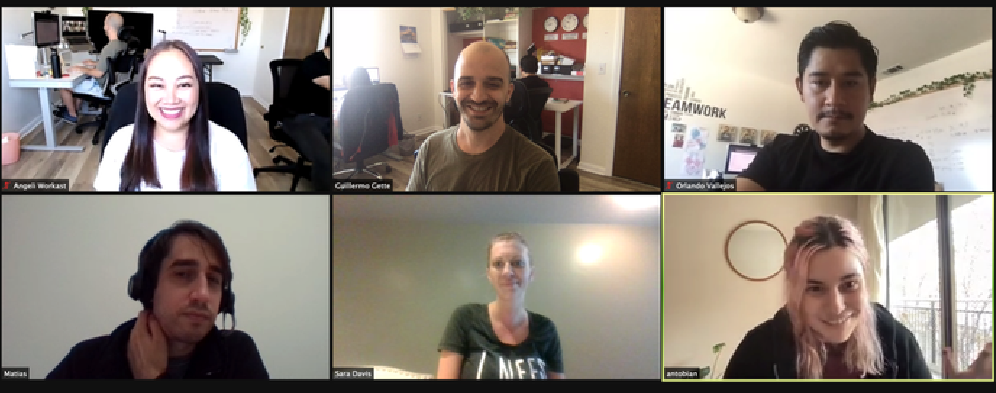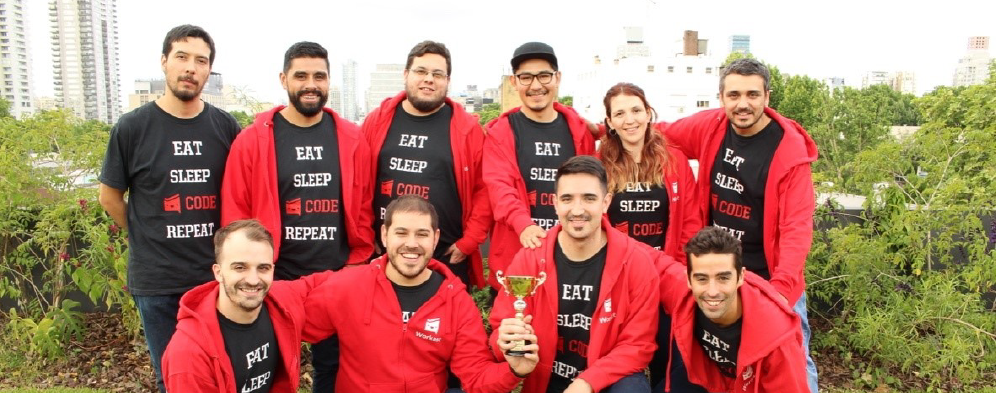To have an effective remote work setup, every organization needs a good project management tool at its helm. Workast is a comprehensive work management platform that serves as the backbone of effective remote work setups.
Workast offers a range of features and functionalities that centralize tasks, projects, and deadlines in one streamlined platform. With its intuitive interface and user-friendly design, Workast simplifies the process of task management and enables teams to collaborate seamlessly. We spoke to the Founder of Workast, Guillermo Gette, to better understand his journey from being a developer to a CEO and the evolution of Workast to what it is today. Through the conversation, we gained insights into the vision and passion that drive Workast's success in the project management industry.
(This interview has been edited for length and clarity)
1. Could you tell us a bit about yourself? We'd love to hear about your background and what led you to where you are today.
I'm originally from Argentina. I lived there until I was 22-23 years old. I always had a passion for computers. I built my first website when I was 12. I had my computer when I was young, and the internet was ready. So, I started building websites. That's how I got on the internet.
I got my job in the US midway through my engineering degree and never got back. When I got to the US, I was part of a startup. I went in as a developer and grew into becoming the CTO. Then life took me to Australia for a couple of jobs in the development field, including Expedia and Yahoo.
In 2017, I decided to go all in for my business which, as you know, is Workast. Initially, it started as a plugin called /todo that lets you create an assigned task. But that very simple tool integration got very popular. So we started the company, raised money, raised a seed round, hired people, and began operations.
From day zero, we had a remote company. And this is where we are today.
2. We'd love to hear more about your business and how it's making a positive impact in remote work. What inspired you to start this business, and how does it help remote workers and companies overcome the challenges of working in a distributed environment?
The experience that led me to get involved with Slack was when Slack was first introduced in 2016. It gained significant popularity and widespread adoption, and I recognized its potential as a platform for businesses. At that time, messaging and chat platforms were already familiar to millennials like me, but the corporate world had not fully embraced them. Slack's user-friendly interface and enjoyable user experience made me believe it was the future of business communication.
While using Slack, particularly during my time at Expedia, I realized it lacked a robust task management feature. I felt the need for a way to seamlessly integrate task creation, assignment, and reminders within the conversational flow of Slack. Although Slack was not officially sanctioned at Expedia, we utilized it unofficially. This experience allowed me to enhance Slack's capabilities and create a task management solution tailored to the platform.
I drew inspiration from the early days of the iPhone, where numerous apps were developed to cater to various use cases. Similarly, I saw an ocean of opportunities in the corporate world to build task management solutions for Slack users. As a software engineer, I value organization and efficiency, essential in coding and software development. Combining my inclination for organization and my desire to build a product I would personally use, I embarked on developing a task management solution for Slack.
Although I questioned whether the market needed another task management solution, I had confidence in my vision and believed others shared my preferences. Therefore, it becomes crucial to identify my target audience and align my product with their needs. By building a product that fulfilled these criteria, I aimed to resonate with people who appreciated the same qualities in a task management tool.
Regarding remote teams, my perspective shifted during my year-long trip with my wife, traveling to various locations across Southeast Asia, Europe, and South America. During our travels, we encountered digital nomads who embraced a location-independent lifestyle while working remotely. This experience opened my eyes to the possibilities of remote work and its advantages. I saw how these digital nomads were able to maintain productivity and collaborate effectively despite being physically distant from their teams.
This realization inspired me to create a product that would cater to the needs of remote teams. I wanted to provide tools and features that would enable seamless collaboration, communication, and task management for remote workers. By understanding the challenges faced by remote teams and drawing from my own experiences, I aimed to develop a solution that would enhance their productivity and overall work experience.

3. Can you tell us about your current work setup? Are you currently working remotely and/or managing a completely distributed team? And what led you to choose this setup?
During the period when my wife and I were working on building our own venture, we had savings that let us travel around without having to work. However, we would bring our laptops wherever we went and would sometimes take breaks or explore new places while still staying productive. It wasn't all constant sightseeing; we aimed to have a somewhat normal routine and keep ourselves engaged with work during our travels.
Being surrounded by other digital nomads and hearing their stories, we were inspired by their freedom and flexibility. It made us question the need for physical office space and the many meetings and commuting associated with traditional work environments. As millennials, we had a different perspective and questioned the necessity of being tied to a physical location when the work could be done effectively remotely. This, combined with reading about early-stage companies embracing remote work, fueled our desire to build a remote company ourselves.
The remote lifestyle appealed to us as it provided the opportunity to spend more time with family and pursue personal interests. It offered a better work-life balance, eliminating the need for long commutes and allowing us to focus on what we truly enjoyed. We wanted to create a company that embraced this lifestyle, giving our team members the same flexibility and freedom.
At the time, around 2016-2017, remote work was still a relatively new concept, and there were some reservations about it. Even when talking to investors and raising funds, the idea of running a remote company was met with skepticism. The expectation was still there to meet investors in person, and some clients preferred face-to-face interactions. However, we saw the potential and benefits of remote work, even if it wasn't fully embraced by everyone at that time. We delayed our return to Australia because we wanted to cater to the expectations of investors and clients who preferred in-person meetings, but our vision for the company remained focused on remote work and the associated lifestyle.
4. What has been your experience with remote work, and how has it differed from working in a traditional office environment?
At the time we started our remote team, there weren't many resources available for guidance. We had to rely on trial and error to figure out how to effectively manage a remote team. The novelty of remote work played a role as well, as people were excited to be part of a remote company. Team motivation and other challenges that come with remote work emerged later on as the concept became more mainstream.
Initially, we used Slack for communication and tools like Trello for project management. Google Docs and Google Sheets were essential for collaborating online. Video calls were mainly conducted using Google Meet, as it was the primary option available at the time. These tools provided us with the necessary means to operate as a remote team.
However, as remote work gained popularity and companies started adopting it on a larger scale, new challenges surfaced. Issues such as creating a remote team culture and managing efficient communication became more apparent. We had to start looking for solutions and learning from other companies that had already tackled these challenges.
Over time, more tools and resources became available to support remote teams, addressing specific issues they faced. The rapid growth and popularity of remote work led to the development of specialized tools and platforms designed to enhance remote collaboration and team management.
As the remote work landscape evolved, we had to adapt and seek out solutions that would help us effectively manage our remote teams and overcome the unique challenges that emerged with the expansion of remote work culture.
5. Communication is crucial for a remote team's success, especially when team members are in different locations and time zones. How do you keep everyone in sync and ensure everyone stays connected and engaged despite the distance?
Initially, when we started using Slack for communication, we encountered some challenges. For example, there were instances where someone would be online on Slack but wouldn't respond right away, causing delays. Some team members would send messages with just a simple "Hello" without providing any context or purpose, leading to unnecessary back-and-forth exchanges. These issues prompted us to address communication guidelines and create guides to establish clear expectations.
We took inspiration from GitLab, a well-known remote company that had comprehensive policies covering various aspects of remote work, including communication. We began creating our own guides, such as Slack communication guidelines, to address specific issues. For example, we encourage team members to update their status on Slack if they are taking a break, going to the gym, or having a meal, to set expectations regarding availability and response times. We emphasized the importance of direct communication and encouraged team members to go straight to the point in their messages.
Another aspect we focused on was the separation of conversations based on their relevance to tasks. While we had a task manager for project-related discussions, we ensured that certain conversations remained within the task context for better organization and clarity. We minimized the use of email within the team, reserving it primarily for customer communication and support.
We also implemented the use of Calendly for internal meetings, allowing team members to book meetings directly through the platform. This approach eliminated scheduling conflicts and made it easier for everyone to find available meeting times. It fostered proactive communication and ensured that time was used efficiently.
To document and communicate these guidelines, we created an ongoing document that served as a reference for team members. It was regularly updated and shared with new hires during their onboarding process. Having these guidelines in place helped establish a consistent communication culture within the team and prevented misunderstandings.
Overall, we learned the importance of being proactive rather than reactive in remote communication. By setting clear expectations, utilizing appropriate tools, and documenting guidelines, we created a more efficient and harmonious remote work environment.
6. Communication is crucial for a remote team's success, especially when team members are in different locations and time zones. How do you keep everyone in sync and ensure everyone stays connected and engaged despite the distance?
When it comes to collaboration, we've explored various tools like Mural boards for visual charts and brainstorming sessions. Recently, we even tried using Oculus or Meta Quest headsets for virtual meetings. With the Oculus Workrooms feature, you can invite people without headsets, and they appear as if they're sitting at a table while you're in a virtual office. It's an immersive experience where you can see each other's movements and interact with a virtual whiteboard. It's quite a unique and forward-thinking experience, unlike anything else.
7. How often do you use that feature? Is it something you use frequently?
To be honest, we haven't used it extensively. It takes time to set up the headsets, and for our work purposes, the benefits weren't significant compared to a regular video call. It might be more valuable for people in design-related roles or those who require a more immersive experience. For our work, which focuses more on organization and collaboration, the benefits weren't as apparent. However, it was an interesting experiment, and we had some fun with it. We even played games like Pictionary or other online multiplayer games during breaks, adding a bit of enjoyment to our remote interactions.
8. How do you keep team morale high, boost team spirit, and promote a positive team culture despite the distance?
One of the most impactful aspects of our team dynamics is the need for in-person meetings. We organize company retreats, which are significant for us, despite being a small team. It's a chance for everyone to come together in the same city for a week, regardless of how long they've been working with us. We fly people in from different places, and it has a huge positive impact on team morale and camaraderie. During these retreats, we go out for dinners and drinks and get to know each other on a personal level. It creates a stronger bond among team members, and we can have more flowing meetings where we understand each other's lives beyond work.

9. How often do you have these retreats? Is it a regular occurrence?
Ideally, we aim to have them twice a year, roughly every six months. We believe this frequency strikes a balance between the benefits of in-person interaction and the practicalities of remote work. Apart from the retreats, we also have weekly activities to foster team bonding. We dedicate half an hour each week to play games, ask questions, or engage in show-and-tell sessions. It's an opportunity for team members to share their experiences, present their work, and practice their presentation skills. Occasionally, we even organize virtual "after-work drinks" where everyone brings something to eat or drink, creating a relaxed and social atmosphere.
10. How do you handle birthdays or other special occasions?
For birthdays, instead of a traditional cake celebration, we send a cake to the person on their special day. It's a fun and thoughtful gesture that brings some joy. Additionally, we sometimes have small budget allowances for team members to buy something they enjoy for their workspaces. They can share what they purchased during our meetings. We strive to strike a balance between creating a supportive and engaging environment while also recognizing that some team members may prefer to focus solely on their work. We consider their preferences and ensure that our activities and meetings are varied and interesting, with a mix of engagement and work-related discussions.
11. It sounds like a great mix of activities, especially with the team retreats and regular engagement sessions. It must create a strong sense of connection within the team.
Absolutely. The team retreats and regular activities contribute significantly to building a sense of connection and camaraderie. They foster a positive team culture and help us work better together, even when we're physically apart or spread across different parts of the world. We believe in the importance of providing opportunities for everyone to engage and be part of the team, regardless of their location.
Yeah, we've had some cool places for our retreats. One memorable one was in Argentina. We have a significant number of developers there, so it made sense to have the retreat in that location. It was a great opportunity for me personally since I have family there, so I could combine the retreat with visiting them. As for deciding on the location and activities, it's a collaborative process. We gather input from team members and make decisions together on what to do and where to go. It's important to involve everyone and ensure the retreat is enjoyable and beneficial for the whole team.
12. For someone who is new to remote work, what resources would you recommend for them to help them get started and be successful in their role? Are there any specific tools, books, websites, or communities that you found helpful and would recommend to others (apart from SIWOM of course ;))?
GitLab is one of the most universal, popular ones. There is also a book by Basecamp called Remote Not Required, which is great for beginners.
 Interested in Virtual Team Building Events?
Interested in Virtual Team Building Events?





















